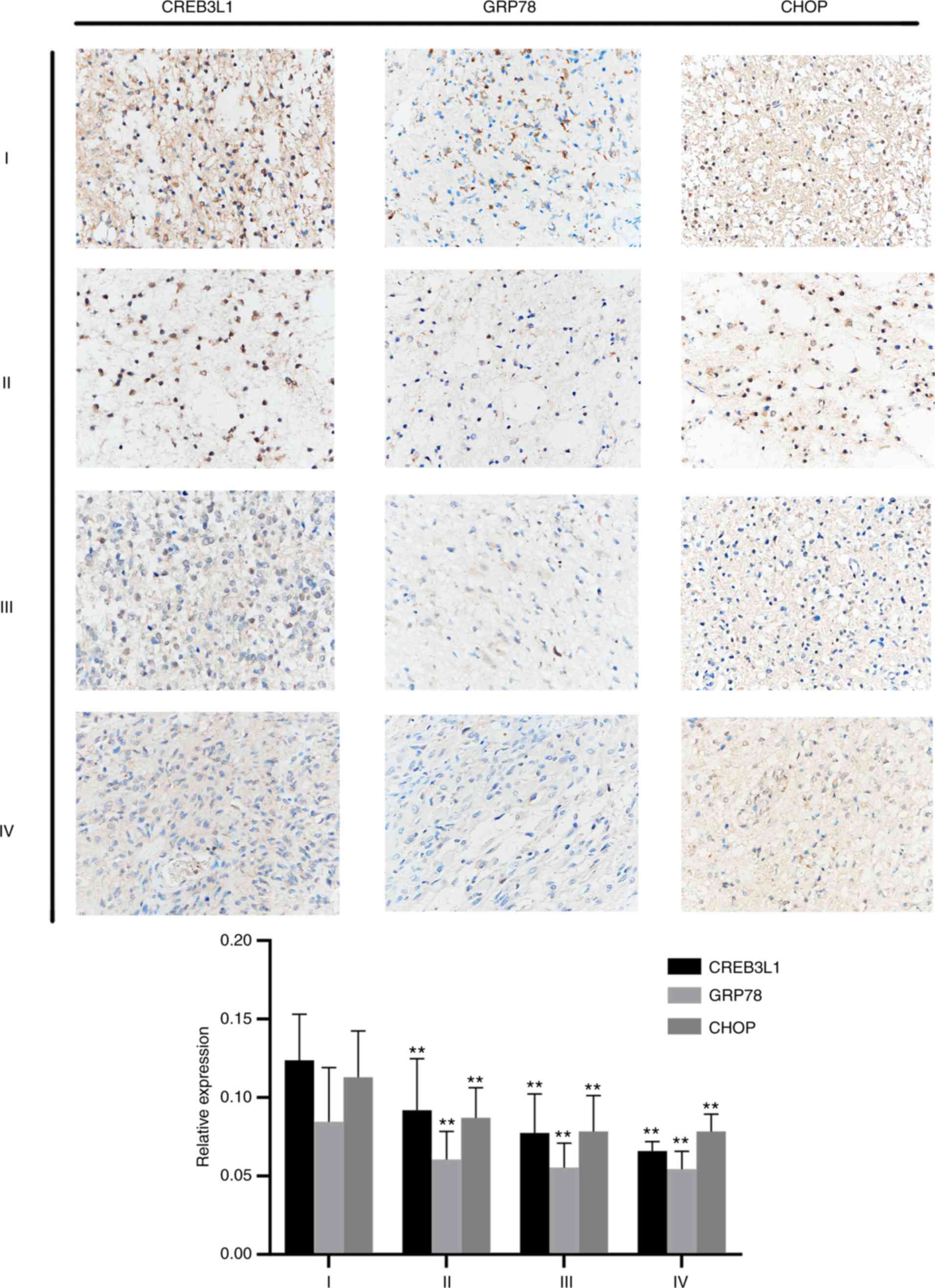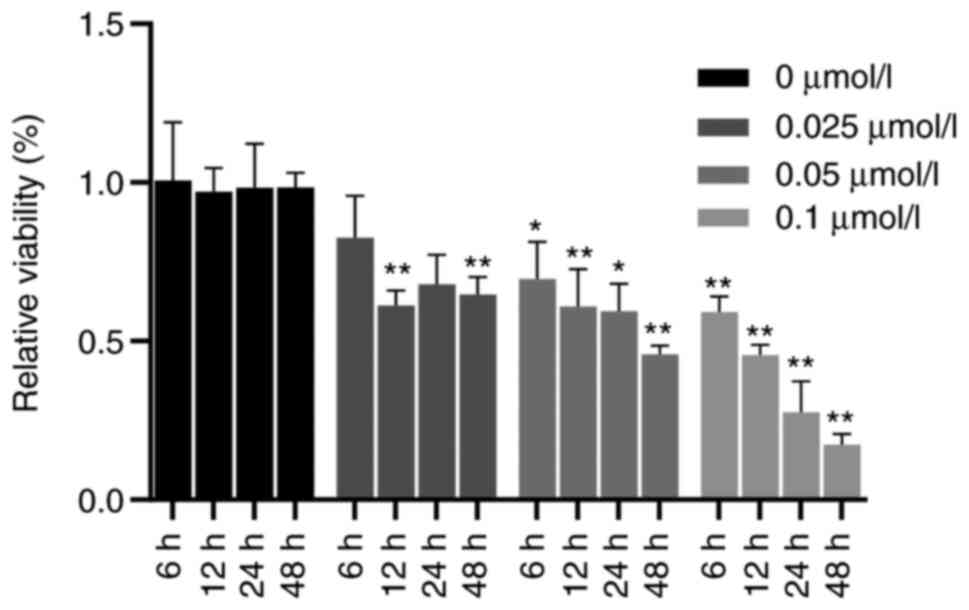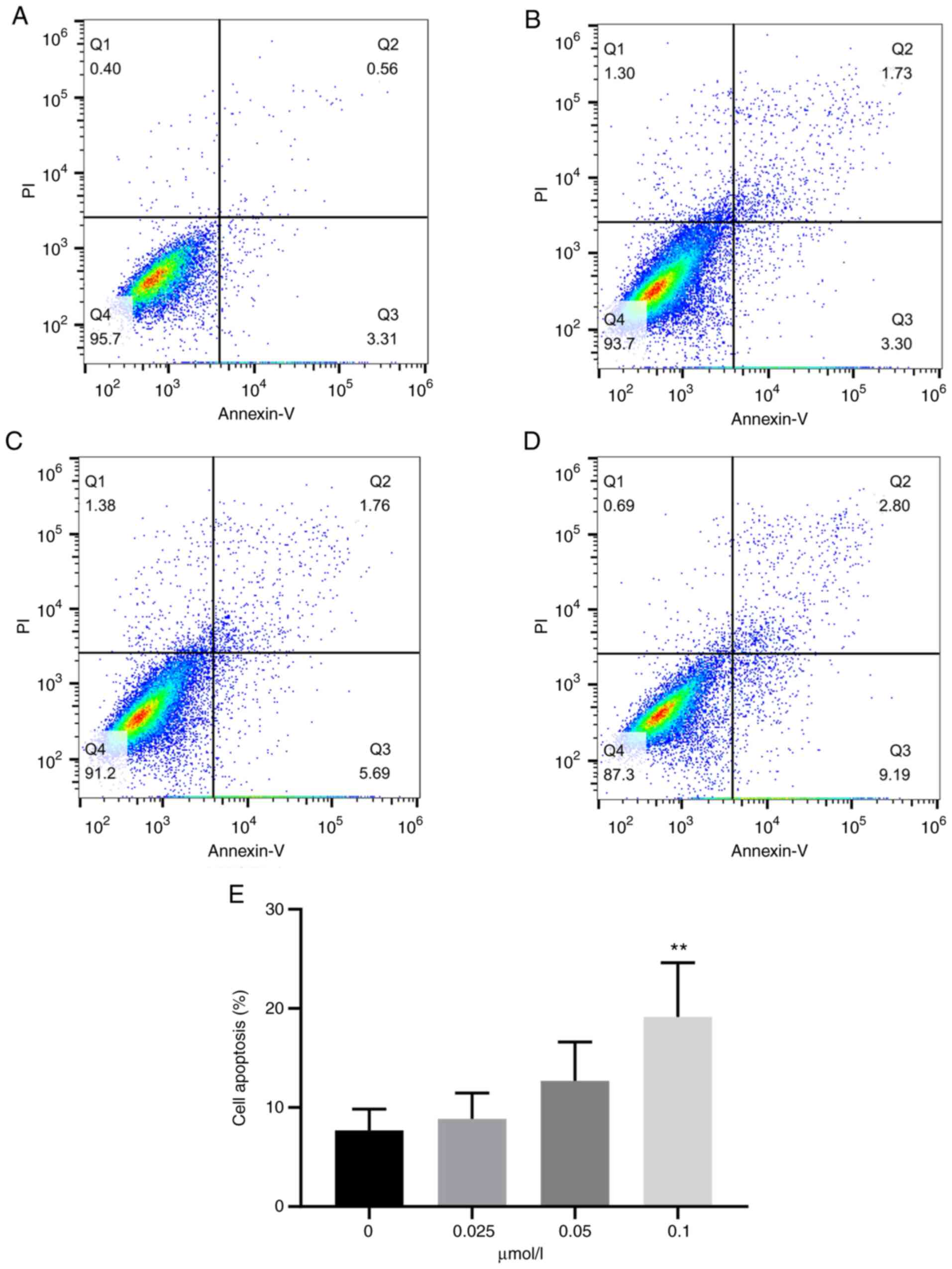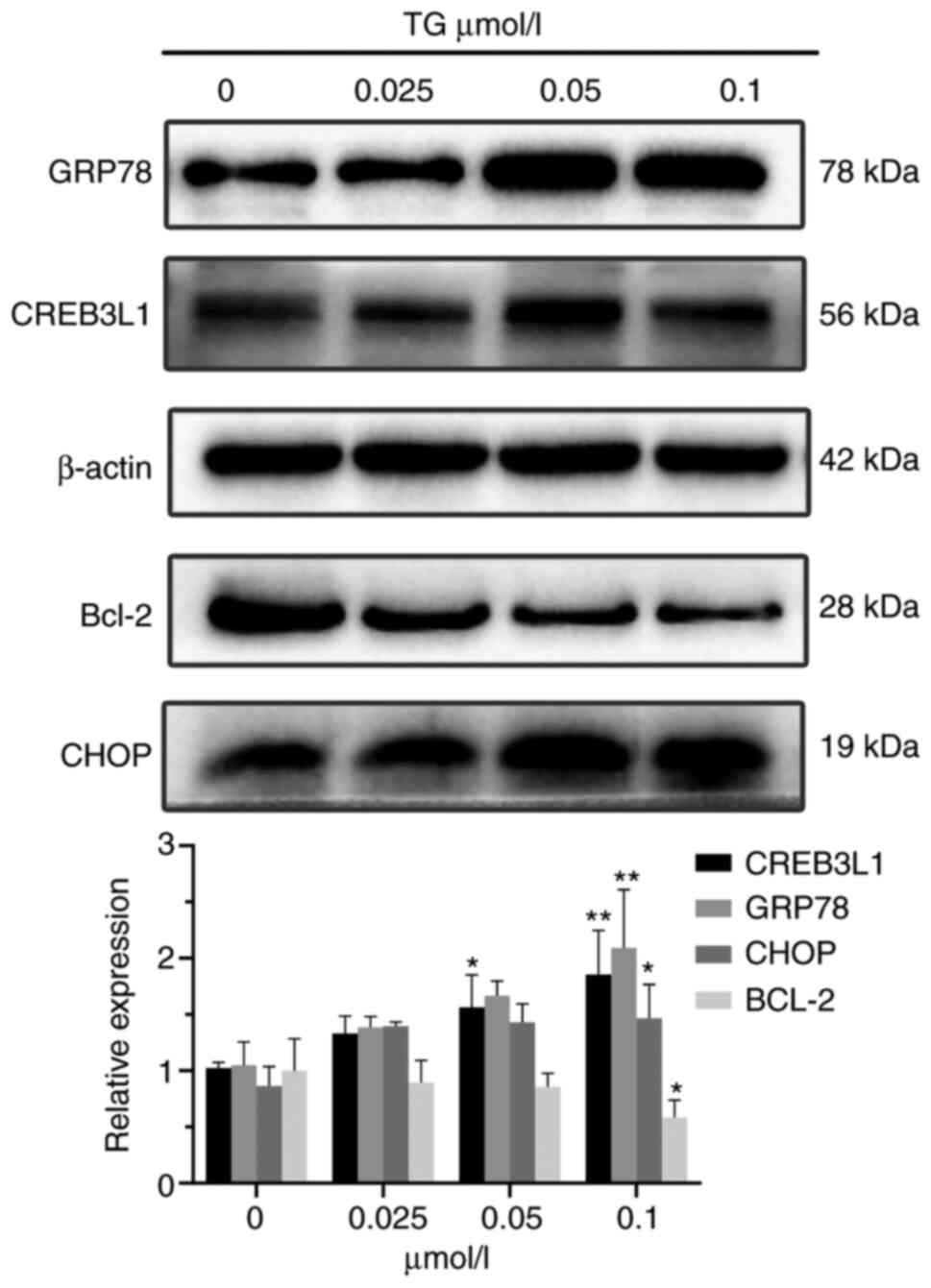|
1
|
Lapointe S, Perry A and Butowski NA:
Primary brain tumours in adults. Lancet. 392:432–446.
2018.PubMed/NCBI View Article : Google Scholar
|
|
2
|
Chavda V, Patel V, Yadav D, Shah J, Patel
S and Jin JO: Therapeutics and Research Related to Glioblastoma:
Advancements and future targets. Curr Drug Metab. 21:186–198.
2020.PubMed/NCBI View Article : Google Scholar
|
|
3
|
Qi Z and Chen L: Endoplasmic reticulum
stress and autophagy. Adv Exp Med Biol. 1206:167–177.
2019.PubMed/NCBI View Article : Google Scholar
|
|
4
|
Sehgal P, Szalai P, Olesen C, Praetorius
HA, Nissen P, Christensen SB, Engedal N and Møller JV: Inhibition
of the sarco/endoplasmic reticulum (ER) Ca2+-ATPase by
thapsigargin analogs induces cell death via ER Ca2+
depletion and the unfolded protein response. J Biol Chem.
292:19656–19673. 2017.PubMed/NCBI View Article : Google Scholar
|
|
5
|
Chan CP, Kok KH and Jin DY: CREB3
subfamily transcription factors are not created equal: Recent
insights from global analyses and animal models. Cell Biosci.
1(6)2011.PubMed/NCBI View Article : Google Scholar
|
|
6
|
Denard B, Jiang S, Peng Y and Ye J:
CREB3L1 as a potential biomarker predicting response of triple
negative breast cancer to doxorubicin-based chemotherapy. BMC
Cancer. 18(813)2018.PubMed/NCBI View Article : Google Scholar
|
|
7
|
Liu LQ, Feng LF, Nan CR and Zhao ZM:
CREB3L1 and PTN expressions correlate with prognosis of brain
glioma patients. Biosci Rep: May 22, 2018 (Epub ahead of
print).
|
|
8
|
Morishita S, Yasuda H, Yamawaki S, Kawaji
H, Itoh M, Edahiro Y, Imai M, Kogo Y, Tsuneda S, Ohsaka A, et al:
CREB3L1 overexpression as a potential diagnostic marker of
Philadelphia chromosome-negative myeloproliferative neoplasms.
Cancer Sci. 112:884–892. 2021.PubMed/NCBI View Article : Google Scholar
|
|
9
|
Li XT, Tang W, Xie HJ, Liu S, Song XL,
Xiao Y, Wang X, Cheng L and Chen GR: The efficacy of RGD modified
liposomes loaded with vinorelbine plus tetrandrine in treating
resistant brain glioma. J Liposome Res. 29:21–34. 2019.PubMed/NCBI View Article : Google Scholar
|
|
10
|
Markouli M, Strepkos D, Papavassiliou AG
and Piperi C: Targeting of endoplasmic reticulum (ER) stress in
gliomas. Pharmacol Res. 157(104823)2020.PubMed/NCBI View Article : Google Scholar
|
|
11
|
Li Y, Ma H, Lu Y, Tan BJ, Xu L, Lawal TO,
Mahady GB and Liu D: Menoprogen, a TCM herbal formula for
menopause, increases endogenous E2 in an aged rat model of
menopause by reducing ovarian granulosa cell apoptosis. Biomed Res
Int. 2016(2574637)2016.PubMed/NCBI View Article : Google Scholar
|
|
12
|
Hassan M, Watari H, AbuAlmaaty A, Ohba Y
and Sakuragi N: Apoptosis and molecular targeting therapy in
cancer. Biomed Res Int. 2014(150845)2014.PubMed/NCBI View Article : Google Scholar
|
|
13
|
Penaranda Fajardo NM, Meijer C and Kruyt
FA: The endoplasmic reticulum stress/unfolded protein response in
gliomagenesis, tumor progression and as a therapeutic target in
glioblastoma. Biochem Pharmacol. 118:1–8. 2016.PubMed/NCBI View Article : Google Scholar
|
|
14
|
Song S, Tan J, Miao Y, Li M and Zhang Q:
Crosstalk of autophagy and apoptosis: Involvement of the dual role
of autophagy under ER stress. J Cell Physiol. 232:2977–2984.
2017.PubMed/NCBI View Article : Google Scholar
|
|
15
|
Kondo S, Saito A, Asada R, Kanemoto S and
Imaizumi K: Physiological unfolded protein response regulated by
OASIS family members, transmembrane bZIP transcription factors.
IUBMB Life. 63:233–239. 2011.PubMed/NCBI View
Article : Google Scholar
|
|
16
|
Vellanki RN, Zhang L and Volchuk A:
OASIS/CREB3L1 is induced by endoplasmic reticulum stress in human
glioma cell lines and contributes to the unfolded protein response,
extracellular matrix production and cell migration. PLoS One.
8(e54060)2013.PubMed/NCBI View Article : Google Scholar
|
|
17
|
Kondo S, Hino SI, Saito A, Kanemoto S,
Kawasaki N, Asada R, Izumi S, Iwamoto H, Oki M, Miyagi H, et al:
Activation of OASIS family, ER stress transducers, is dependent on
its stabilization. Cell Death Differ. 19:1939–1949. 2012.PubMed/NCBI View Article : Google Scholar
|
|
18
|
Jaskulska A, Janecka AE and Gach-Janczak
K: Thapsigargin-from traditional medicine to anticancer drug. Int J
Mol Sci. 22(4)2020.PubMed/NCBI View Article : Google Scholar
|
|
19
|
Wang H, Jia XZ, Sui CJ, Zhao YP, Mei YF,
Zheng YN and Zhang ZY: Effects of thapsigargin on the proliferation
and survival of human rheumatoid arthritis synovial cells.
ScientificWorldJournal. 2014(605416)2014.PubMed/NCBI View Article : Google Scholar
|
|
20
|
Raiter A, Lipovetsky J, Hyman L, Mugami S,
Ben-Zur T and Yerushalmi R: Chemotherapy controls metastasis
through stimulatory effects on GRP78 and its transcription factor
CREB3L1. Front Oncol. 10(1500)2020.PubMed/NCBI View Article : Google Scholar
|
|
21
|
Xiao W, Liang Y, Que Y, Li J, Peng R, Xu
B, Wen X, Zhao J, Guan Y and Zhang X: Comparison of the MAID (AI)
and CAV/IE regimens with the predictive value of cyclic
AMP-responsive element-binding protein 3 like protein 1 (CREB3L1)
in palliative chemotherapy for advanced soft-tissue sarcoma
patients. J Cancer. 10:3517–3525. 2019.PubMed/NCBI View Article : Google Scholar
|
|
22
|
Zhu HY, Bai WD, Liu JQ, Zheng Z, Guan H,
Zhou Q, Su LL, Xie ST, Wang YC, Li J, et al: Up-regulation of
FGFBP1 signaling contributes to miR-146a-induced angiogenesis in
human umbilical vein endothelial cells. Sci Rep.
6(25272)2016.PubMed/NCBI View Article : Google Scholar
|
|
23
|
Cui X, Cui M, Asada R, Kanemoto S, Saito
A, Matsuhisa K, Kaneko M and Imaizumi K: The androgen-induced
protein AIbZIP facilitates proliferation of prostate cancer cells
through downregulation of p21 expression. Sci Rep.
6(37310)2016.PubMed/NCBI View Article : Google Scholar
|


















